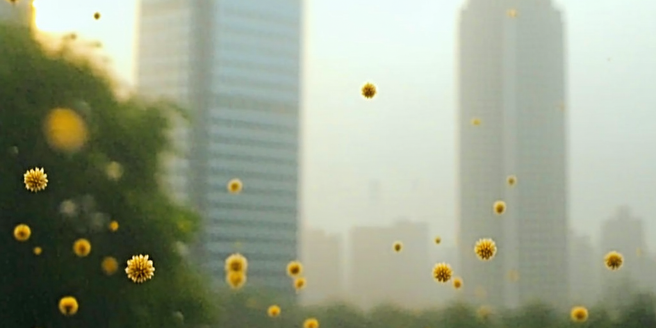
Understanding Pollen Counts and Their Impact on Health
Pollen counts are essential metrics for gauging potential allergenic exposure in urban areas. They represent the concentration of pollen grains in a given volume of air. Higher pollen counts often correlate with increased allergic reactions, particularly for individuals sensitive to specific types of pollen, such as grass, weed, or tree pollen. When individuals are exposed to high pollen levels, they may experience symptoms like sneezing, nasal congestion, itchy eyes, and even asthma exacerbations. Understanding pollen counts helps in planning outdoor activities and managing exposure, which is crucial for people with respiratory conditions. Health professionals often advise those at risk to monitor daily pollen forecasts, as these can vary greatly depending on the season and the prevailing environmental conditions. Effective management can lead to improved quality of life for allergy sufferers.
Factors Contributing to High Pollen Levels in Cities
Urban areas often experience elevated pollen levels due to a variety of factors that amplify natural pollen production. The high concentration of vehicles in cities contributes considerably to air pollution, which can increase the allergenicity of pollen. In addition, urban heat islands—areas that are significantly warmer than their rural surroundings—create conditions that prolong the pollen season. Landscaping practices that favor the use of male plants, which produce more pollen, further amplify pollen levels. The density of buildings and reduced open spaces also contribute by limiting airflow, causing pollen to remain suspended in the air longer than it might otherwise. Moreover, certain architectural designs and materials can inadvertently collect pollen, releasing it into the air under certain climatic conditions. These factors make understanding and managing urban pollen dynamics a complex issue.
Seasonal Trends in Urban Pollen Counts
Pollen counts in urban environments exhibit distinct seasonal patterns driven by the life cycles of local vegetation. In many regions, tree pollen peaks in the spring when trees like birch and oak release their pollen. This is followed by grass pollen, typically reaching its highest concentrations in the late spring and early summer. Weed pollen, including the notorious ragweed, tends to dominate the late summer and fall. These seasonal trends can be influenced by local climate conditions, such as temperature variations and rainfall, which affect the timing and duration of pollen seasons. Urban microclimates can further alter these trends, making precise predictions challenging. Knowing these patterns allow individuals with allergies to prepare and take preventive measures, such as using allergy medications or reducing outdoor activities during peak pollen times.
The Role of Climate Change in Pollen Variability
Climate change is increasingly recognized as a key driver of changes in pollen dynamics, impacting urban areas significantly. Rising CO2 levels and temperatures lead to longer growing seasons and increased pollen production by vegetation. Some studies suggest that the allergenic potency of pollen may also increase alongside CO2 enrichment. This phenomenon exacerbates allergic reactions and poses heightened risks for sensitive populations. Additionally, unpredictable weather patterns, such as sudden temperature spikes or extreme precipitation, can influence the timing of pollen release, making it more difficult for those with allergies to manage their symptoms. Urban planners and public health officials are growing increasingly aware of these impacts and are exploring adaptive measures to mitigate potential health risks associated with changing pollen patterns.
Mitigating Allergies: Tips for Urban Dwellers
For urban residents, mitigating allergy symptoms involves a multi-faceted approach. Begin by monitoring daily pollen forecasts to plan outdoor activities when pollen counts are lower. Keeping windows closed during high pollen seasons can prevent outdoor allergens from entering living spaces. Using air purifiers with HEPA filters can help in reducing indoor pollen concentrations. Showering and changing clothes after being outside is an effective strategy to remove pollen particles. Avoid outdoor activities in the early morning when pollen release peaks. Incorporating anti-inflammatory foods and over-the-counter antihistamines into your routine may also offer relief. For severe allergies, consulting an allergist for possible immunotherapy could be beneficial. Awareness and proactive management are key in reducing the discomfort caused by urban pollen exposure, particularly during peak times.
Future Predictions for Urban Pollen Trends
As urban environments continue to evolve, predicting future pollen trends involves understanding a complex interplay of factors. Urban expansion and densification may lead to increased pollen production as green areas are transformed into residential and commercial zones with carefully selected vegetation. Advances in technology and data analytics offer promising tools for more accurate pollen forecasts, potentially incorporating satellite data and machine learning techniques. Climate change models suggest that pollen seasons will likely start earlier and last longer due to rising temperatures and CO2 levels. For urban planners and public health officials, this underscores the need for adaptive strategies to manage allergen exposure and health risks. Continued research is essential for devising effective public policies and ensuring urban resilience in the face of evolving pollen dynamics.
